Earlobedus (aer-lobe-dus) was a malady that seemed unique to first-year campers at Boy Scout Camp Tish Tang on Highway 96 just south of the Hoopa reservation. It was said to be a fungus that grew only in the ears of those scouts at camp for the first time. The treatment called for painting the ears and surrounding skin with Mercurochrome, thus giving the patient bright reddish-orange ears. As camp first-aid orderly in 1952, I treated several such cases.
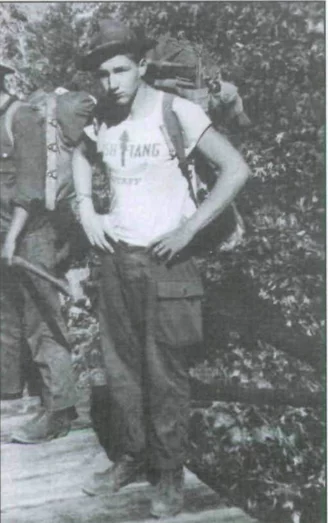
Ray Oliver at the start of the 1951 Explorer Scout week-long wilderness backpacking hike into the Marble Mountains. Photos via the Humboldt Historian.
Earlobedus was the most successful of the usually crude and sometimes cruel jokes visited on the gullible or unwary. Another was to arrange several guys around a nest of big, black ants and trick the victim into standing on the nest while engaged, he thought, in friendly chatter.
Evening campfires on the Trinity River beach across from Tish Tang a Tang Creek provided another trick opportunity. The beach was about half a mile through the woods from camp. When a boy fell asleep, the rest of us would quietly slip away a few yards. We would then throw dirt clods at the sleeper so he would wake up to find himself apparently alone in the dark.
The camp namesake, Tish Tang a Tang Creek, flowed out of the Hoopa reservation across the Trinity River from the camp. The creek name supposedly meant a hook or curve because the creek flowed southward into the northward flowing river, thus causing the creek water to curve northwards.
The more famous camp tricks seldom if ever seemed to work. Among these were dipping a sleeper’s hand in warm water, snipe hunts, and Ex-Lax in somebody’s food — we didn’t dare eat chocolate pudding. One dark night we sent a kid out with the bag and flashlight lo catch snipe while the rest of us went off to chase the elusive creatures to him. We worked our way back to the campfire to find the kid sitting there roasting marshmallows. He made a few profanity laced comments to the effect that we must be pretty dumb to think he would fall for such a stupid trick.
The camp was organized into villages. Three villages — Riverside, Rockefeller Center and Sherwood Forest — consisted of Army surplus, eight-boy squad tents that featured center poles. The poles were constant targets since upon removal, usually late at night, the tent would collapse on the sleepers. To protect the poles, we tried nailing them to wooden floors, tying them to the beds or placing barricades around them. These efforts required inventiveness by pole removers. One tactic called for several “friendly” guys to walk into a tent and stand around the pole talking while one of their number knelt down, apparently to tie a shoelace. That miscreant would remove the nail or cut the rope protecting the pole, then the whole group would run out taking the pole with them. Sometimes the pole would be removed during the daytime when we were all gone swimming or at lunch and carried off into the woods and poison oak, thus forcing us to search for it. One night the inevitable happened; a falling tent pole hit and injured a kid. The camp director, Scout Executive Levi Young, decreed that the pole-stealing would no longer be tolerated.
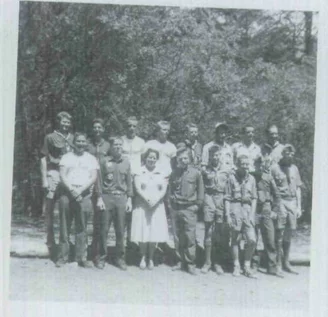
Tish Tang Camp staff, 1953. From left to right: (back row) unknown, Tom Hill, Jerry Hasz, Rod Trogo, Dan McLellan, unknown, Pete Vallerga, Levi Yonng. (front row) John Burger, Wes Martin, Adelee Hasz, Nile Henderson, Rich Sloma, Zay Jorlano, unknown, unknown.
Sometimes the intended victim outsmarted the trickster. In 1951. we had to put up with a particularly disliked junior staffer I shall call “O” for obnoxious. He seemed to relish alienating people. We ate at long tables in the mess hall — not dining “facility” but “mess hall” — with a staff member at each table. At each meal, an inspector would choose the neatest and sloppiest table. The neatest got a cutout of Marilyn Monroe and the sloppiest, a ceramic pig. These stayed on the tables until the next meal or until other tables earned them.
Marlin Brady, the cook, also disliked O. One lunch, Brady hollowed out half a hot dog and filled it with pepper. We used the table waiter system in which one kid would get the food for the whole table. Brady put the re-closed, pepper-filled hot dog on top of the plate of dogs going to O’s table, and told the waiter to give the plate to O first. O took the pepper dog, bit off the good end and saw the pepper. He put the now half-hot dog on the plate coming to my table. As the plate arrived, a lad from Crescent City grabbed the really hot hot dog, stuffed it into his mouth, and immediately grabbed the pitcher of the bug juice (bug juice was a Kool-Aid type drink in which the dregs of the powder resembled bugs when it settled to the bottom of the pitcher), spilling it, water and food, all over the table. We got the pig that day.
Camp Tish-Tang was the Boy Scout Redwood Area Council’s summer camp from 1948 to 1964. When Trinity River floods damaged the area camp, it had to be abandoned. It is now a Forest Service camping area. On my last visit some twenty years ago, I was saddened to see that only a very few of the structures — some that I helped build — remained. Much of the building work was done by work parties on the weekends in the Spring. A few days before camp opened in June, a small advance guard would go to set up the camp and get things ready for the camp period, usually three to four weeks. After the camp period, a rear guard would stay for a few days to close up and do other jobs on the road, structures and waterfront area.
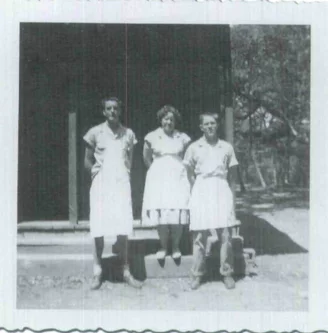
Cooking staff at Tish Tang, 1953. left to right: Pete Vallerga, Adelee Hasz (camp cook), and Wes Martin.
The late 1940s and early ‘50s were, of course, shortly after World War II and during the Korean War. Many of the adult staffers had recently served in the military, so that might account for the use of military terms: advance guard, rear guard, mess hall, K.P., first aid orderly, canteen, retreat formation, troops, patrols, latrines, officer of the day and others. We also used quite a bit of military surplus, especially the food. Who could forget the powdered eggs and dried potato cubes? There was also a flat, disc-shaped chocolate candy that had been made in the tropics. The stuff did not melt or get soft in the hand or mouth. We had to break off a piece and chew it for awhile to soften it up. Another favorite was a kind of rubbery cheese that came in big hunks. We had to break off chunks and chew them for a while as well. After a few times, we rather liked the stuff. Perhaps the favorite was the bug juice Kool-aid. The camp was in a valley that got very warm during the day so we all looked forward to the bug juice.
The warmth and humidity seemed to make poison oak grow into big bushes and even small trees. We heard that urine would kill the poison oak. We did our best, but the stuff thrived. Our efforts created another problem — for example, junior staffers had to regularly bring around hoses and water down around the tents and other sleeping areas. Along with the squad tent villages, we had sleeping areas of open-front Adirondack cabins, kiosks and various shelters. It seldom rained during the June camping period.
Sleeping could be a problem when there was a snorer. Don Raffaelli of Eureka told me how his group solved the problem once in 1948. They picked the snorer’s bed — we used military steel cots so many would come to know in later years — and carried it and the apparently very sound sleeper to the river and placed them in the water.
Then the group waited for the victim to wake up. The bugler put some extra wind into his morning call to make sure the snorer woke to cheers of his tentmates. Camp Director Levi Young failed to see the humor in the situation and put Raffaelli and his co-conspirators to work cleaning toilets. Despite this and innumerable other transgressions, Raffaelli eventually became the Humboldt County Director of Public Works.
Toilets were a major area of attention, as might be expected of the gang of teenage boys. We had a daily health and safety detail to clean them. The smallest boy on the detail would be told by the detail leader — whose title was “the outhouse mouse” — that he. the smallest boy, would have to “go down the hole” in the twofor privies. That meant, he was told, a rope would be tied about his waist and he would be lowered through the hole in the seat to clean the wooden supports inside. After several such threats and even showing the small boy the rope, the outhouse mouse would decide the job was not necessary “this time.”
The privies did not have names as did those at a camp I attended in Wisconsin. There, they were named Coca-Cola for the pause that refreshes, First National for making deposits, and Little Egypt for building pyramids.
When the camping period ended, we had several days when a few of the staff stayed to fold the tents, close the waterfront area, put things away and do various repair jobs. On the last day of the rear guard in 1951, Levi Young decided to take a hike across the river to a box canyon he wanted to look at as a site for future overnight hikes. It was a pleasant hike along a small creek. Coming back later that day. we followed the same trail we had taken in the morning. In the trail, we saw cougar tracks on top of the tracks we had made that morning. The cougar tracks were going the same direction we had. We wondered if the cougar had been thinking of joining the Scouts for lunch. Maybe we smelled too bad.
Kay (Smeltzer) Oliver receives the Eagle Scout award from Judge Donald Wilkinson on January 8, 1952 during a Boy Scout Court of Honor at Eureka Elks Club. Oliver’s parents Caryl and B. F. Smeltzer watch the ceremony. Note: Judge Wilkinson, who later became Humboldt County Superior Court Judge, was blind. He kept Braille notes for his speech in his pocket.
###
The story above was originally printed in the Summer 2006 issue of the Humboldt Historian, a journal of the Humboldt County Historical Society. It is reprinted here with permission. The Humboldt County Historical Society is a nonprofit organization devoted to archiving, preserving and sharing Humboldt County’s rich history. You can become a member and receive a year’s worth of new issues of The Humboldt Historian at this link.
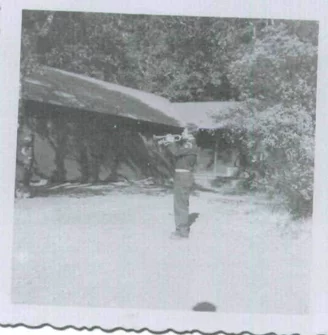
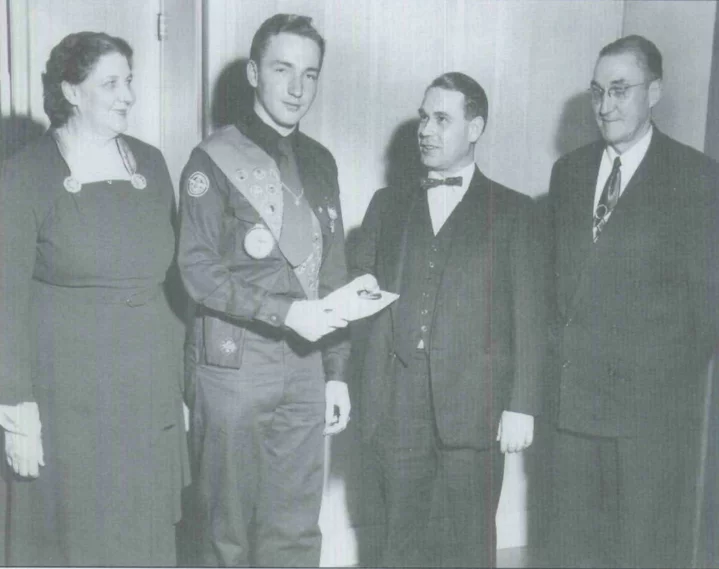
CLICK TO MANAGE